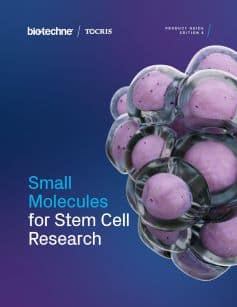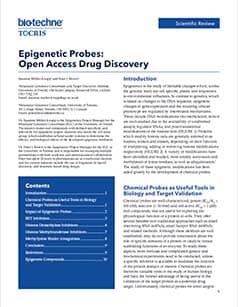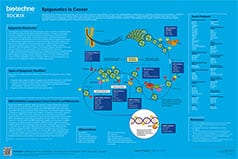Bromodomains
Bromodomains (BRDs) are epigenetic "reader" domains that selectively recognize acetylated lysine (Kac) residues on the tails of histone proteins, and are the only known protein modules that can target acetylated lysine residues.
Bromodomain Inhibitors |
|
|---|---|
| Cat. No. | Product Name / Activity |
| 7757 | AZ 13824374 |
| Potent and selective ATAD2 bromodomain inhibitor | |
| 5970 | BAY 299 |
| Potent and selective BRD1 and TAF1 inhibitor | |
| 5266 | BAZ2-ICR |
| Selective BAZ2 inhibitor | |
| 5590 | BI 9564 |
| Potent and selective BRD9 and BRD7 inhibitor; orally active | |
| 4758 | Bromosporine |
| Broad spectrum bromodomain inhibitor | |
| 7139 | CeMMEC1 |
| TAF1 inhibitor | |
| 5331 | CPI 203 |
| BET bromodomain inhibitor; arrests cell cycle at G1 phase | |
| 7644 | FHT 1015 |
| Potent and selective SMARCA4/2 inhibitor | |
| 7645 | FHT 2344 |
| Potent SMARCA2/4 inhibitor | |
| 6198 | GSK 6853 |
| Potent and selective BRPF1 inhibitor | |
| 4650 | I-BET 151 dihydrochloride |
| BET bromodomain inhibitor; also promotes differentiation of hiPSCs into megakaryocytes | |
| 6521 | I-BET 762 |
| Potent and high affinity BET bromodomain inhibitor; anti-inflammatory; orally bioavailable. | |
| 5591 | I-BRD9 |
| Potent and selective BRD9 inhibitor | |
| 7458 | iBET-BD2 |
| Potent and selective pan-BD2 inhibitor; orally bioavailable | |
| 4695 | Ischemin sodium salt |
| CBP inhibitor; cell permeable | |
| 4499 | (+)-JQ1 |
| Potent and selective BET bromodomain inhibitor; cell permeable | |
| 6251 | L Moses dihydrochloride |
| High affinity and selective PCAF bromodomain inhibitor | |
| 6068 | Lin28 1632 |
| Bromodomain inhibitor; also RNA binding protein Lin28 inhibitor and promotes mESC differentiation | |
| 5496 | LP 99 |
| Selective BRD7 and BRD9 inhibitor | |
| 5546 | NI 57 |
| Potent and selective BRPF bromodomain inhibitor | |
| 7482 | NVS MLLT-1 |
| Selective MLLT1/3 inhibitor | |
| 5744 | NVS-CECR2-1 |
| Potent and selective CECR2 inhibitor | |
| 6181 | OTX 015 |
| BET bromodomain inhibitor; orally bioavailable | |
| 4445 | PFI 1 |
| BET bromodomain inhibitor | |
| 5072 | PFI 3 |
| Potent and selective SMARCA2/4 and polybromo 1 inhibitor | |
| 7460 | SGC SMARCA-BRDVIII |
| Potent and selective SMARCA2/4 and PB1(bromo 5)-selective SWI/SNF bromodomain inhibitor | |
| 4889 | SGC-CBP30 |
| Potent CBP/p300 BRD inhibitor | |
| 6670 | TP 238 |
| CECR2 and BPTF/FALZ inhibitor | |
| 6000 | TP 472 |
| Potent BRD9/7 inhibitor | |
| 4132 | XMD 8-92 |
| BRD4 inhibitor; also ERK5/BMK1 inhibitor | |
Degraders |
|
| Cat. No. | Product Name / Activity |
| 7256 | ARV 771 |
| Potent BET bromodomain PROTAC®; also degrades BRD-tagged chimeric antigen receptors (CAR) in T cells | |
| 6356 | AT 1 |
| (+)-JQ1 based PROTAC® with selectivity for BRD4 | |
| 7319 | BRD PHOTAC-I-3 |
| Photoswitchable BET bromodomain degrader (PHOTAC) | |
| 6327 | dBET1 |
| (+)-JQ1 based Degrader targeting BET bromodomains, active in vivo | |
| 6945 | dBET6 |
| Potent and selective (+)-JQ1 based Degrader targeting BET bromodomains, active in vivo | |
| 6606 | dBRD9 |
| Potent and selective BRD9 Degrader | |
| 6943 | dBRD9-A |
| Potent BRD9 Degrader | |
| 7828 | HHP 9 |
| BET bromodomain degrader; also potent Hedgehog pathway inhibitor | |
| 8152 | JQ dS-4 New |
| BRG1/SMARCA4 Degrader (PROTAC®) | |
| 6154 | MZ 1 |
| BRD4 Degrader; preferentially degrades BRD4 over BRD2/3 | |
| 6936 | VZ 185 |
| Potent and selective BRD7/9 Degrader | |
Controls |
|
| Cat. No. | Product Name / Activity |
| 6155 | cis MZ 1 |
| Negative Control for MZ 1 (Cat. No. 6154) | |
| 7433 | cis-SIM1 |
| Negative control for SIM1 (Cat. No. 7432) | |
| 6939 | cis-VZ 185 |
| Negative control for VZ 185 (Cat. No. 6936) | |
| 5497 | ent-LP 99 |
| Negative Control for LP 99 | |
| 6203 | GSK 9311 hydrochloride |
| Negative control for GSK 6853 | |
| 5603 | (-)-JQ1 |
| Negative control for (+)-JQ1 | |
| 5999 | TP 472N |
| Negative control for TP 472 | |
Other |
|
| Cat. No. | Product Name / Activity |
| 7576 | (+)-JQ1 maleimide |
| JQ1-maleimide functionalized probe; induces proteasomal degradation of BRD4 | |
| 7722 | JQ1-FITC |
| Fluorescent BET bromodomain probe; suitable for use in TR-FRET | |
Bromodomain Structure and Function
There are approximately 61 unique human Bromodomains. These protein modules have been identified in 42 proteins with diverse functions from the histone acetyltransferase (HAT) PCAF, which adds acetyl groups to lysine residues on histone tails, to the ATP-dependent helicase SNF2L2. This diversity has made it difficult to characterize the function of a given BRD-containing protein, particularly as some proteins may contain one or more additional epigenetic "reader" domains.
Structurally, bromodomains comprise four α-helices, designated A, B, C and Z, and two loops of different lengths, ZA and BC, forming a hydrophobic pocket that recognizes acetyl lysine (Figure 1). Bromodomains are grouped into eight families based on structure: BRD1, BRD2, BRD3, BRD4, BRD7, BRD8, BRD9 and BRDT.
Bromodomain-containing proteins have an important role in controlling gene expression via remodeling of chromatin, histone modification and recognition and regulation of transcriptional machinery.
BET Bromodomains
Of particular interest is the BET (bromodomain and extra-terminal) bromodomain family, which comprises the ubiquitously expressed proteins BRD2, BRD3, BRD4; and the testis-specific protein, BRDT. BET bromodomains are important in cellular differentiation and proliferation processes, and are characterized by having two distinct histone acetyl-lysine binding sites, denoted BD1 and BD2. BET proteins are key regulators of oncogenic transcription factors, such as MYC.

Figure 1: Schematic showing the structure of bromodomains and the recognition of the acetylated lysine residues (Kac) on histone proteins by BRD4. The right-hand image highlights how bromodomain inhibitors, such as (+)-JQ1, block the binding of BRD4 to Kac.
Bromodomains and Disease
Bromodomains have been implicated in diseases such as cancer and inflammation. In cancer, bromodomain-containing proteins are often deregulated. In addition, mutations in the bromodomains themselves are frequently identified in a variety of cancers. Tumorigenesis and proliferation have been shown to be associated with deregulation of histone acetylation, which drives aberrant expression of growth and survival-promoting genes.
BRD4 is of interest as a therapeutic target for cancer, as a result of its binding to transcriptional sites of genes expressed during the M/G1 cell cycle transition. BRD4 has also been implicated in a rare but lethal form of cancer, NUT midline carcinoma (NUC), which is caused by a rearrangement of the nuclear protein in testis gene (NUT), causing the formation of a BRD4-NUT fusion gene.
In addition, BRD4 has been reported to function as a coactivator for the transcriptional activation of NFκB, which is implicated in the transcriptional control of inflammatory genes. Evidence suggests that BRD4 also plays a significant role in cardiovascular diseases, such as ischemic heart disease, hypertension, and cardiac hypertrophy, neurological disorders and respiratory conditions. BRD4 is also of interest in coronavirus infections, including COVID-19, as it is involved in transcriptional regulation of ACE2 and TMPRSS2, the host proteins that mediate viral cell entry.
Bromodomain Inhibitors and Their Uses
Bromodomain inhibitors such as the BET-selective bromodomain inhibitor (+)-JQ1 (Cat. No. 4499) have been valuable tools for elucidating the functions of bromodomains. In addition, BD1/BD2 selective inhibitors have enabled investigation of the functional activities of the individual binding sites. More recently protein Degraders (aka PROTAC® molecules) have been developed that selectively degrade a bromodomain of interest and allow exploration of the downstream consequences of protein knockdown. For example, MZ 1 (Cat. No. 6154) a PROTAC based on (+)-JQ1, brings about the selective degradation of BRD4 via the proteasome.
Genes regulated by BET are important in controlling cell identity. BRD4 is associated with control of pluripotency genes and maintaining the identity of embryonic stem cells. BET bromodomain inhibitors such as (+)-JQ1 and I-BET-151 (Cat. No. 4650) have been used in stem cell reprogramming protocols.
Bromodomain inhibitors have potential as cancer therapies and are the subject of clinical trials for a range of both solid and hematological tumors. Bromodomain Degraders are also in clinical trials for cancer.
PROTAC® is a registered trademark of Arvinas Operations, Inc., and is used under license.
Literature for Bromodomains
Tocris offers the following scientific literature for Bromodomains to showcase our products. We invite you to request* your copy today!
*Please note that Tocris will only send literature to established scientific business / institute addresses.
Epigenetics Scientific Review
Written by Susanne Müller-Knapp and Peter J. Brown, this review gives an overview of the development of chemical probes for epigenetic targets, as well as the impact of these tool compounds being made available to the scientific community. In addition, their biological effects are also discussed. Epigenetic compounds available from Tocris are listed.
Epigenetics in Cancer Poster
This poster summarizes the main epigenetic targets in cancer. The dysregulation of epigenetic modifications has been shown to result in oncogenesis and cancer progression. Unlike genetic mutations, epigenetic alterations are considered to be reversible and thus make promising therapeutic targets.
Rheumatoid Arthritis Poster
Rheumatoid arthritis (RA) is a chronic destructive inflammatory autoimmune disease that results from a breakdown in immune tolerance, for reasons that are as yet unknown. This poster summarizes the pathology of RA and the inflammatory processes involved, as well as describing some of the epigenetic modifications associated with the disease and the potential for targeting these changes in the discovery of new treatments.
Bromodomain Gene Data
| Gene | Species | Gene Symbol | Gene Accession No. | Protein Accession No. |
|---|---|---|---|---|
| BRD2 | Human | BRD2 | NM_001113182 | P25440 |
| Mouse | Brd2 | NM_001204973 | Q7JJ13 | |
| Rat | Brd2 | NM_212495 | Q6MGA9 | |
| BRD3 | Human | BRD3 | NM_007371 | Q15059 |
| Mouse | Brd3 | NM_023336 | Q8K2F0 | |
| Rat | Brd3 | NM_001108575 | NP_001102045 | |
| BRD4 | Human | BRD4 | NM_058243 | O60885 |
| Mouse | Brd4 | NM_020508 | Q9ESU6 | |
| Rat | Brd4 | NM_001100903 | NP_001094373 | |
| BRDT | Human | BRDT | NM_207189 | Q58F21 |
| Mouse | Brdt | NM_054054 | Q91Y44 | |
| Rat | - | - | - |



